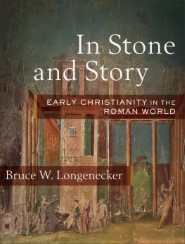In Stone and Story: Early Christianity in the Roman World

Overview
This beautifully designed, full-color textbook introduces the Roman background of the New Testament by immersing students in the life and culture of the thriving first-century city of Pompeii, which found itself right in the path of the spread of the early Christian movement. Bruce Longenecker, a leading scholar of the ancient world of the New Testament, discusses first-century artifacts in relation to the life stories of people from the Roman world. The book includes discussion questions, maps, and 175 color photographs.

- Introduces the Roman background of the New Testament
- Discusses first-century artifacts in relation to the life stories of people from the Roman world
- Includes discussion questions, maps, and 175 color photographs
- Looking Ahead: An Introduction
Part 1: Protocols of Engagement
- Human Meaning in Stone and Story
- Fire in the Bones
- Accessing the First-Century World
- Timeline of Events
Part 2: Protocols of Popular Devotion
- Deities and Temples
- Sacrifice and Sin
- Peace and Security
- Genius and Emperor
- Mysteries and Knowledge
- Death and Life
Part 3: Protocols of Social Prominence
- Prominence and Character
- Money and Influence
- Literacies and Status
- Combat and Courts
- Business and Success
Part 4: Protocols of Household Effectiveness
- Household and Slaves
- Family and Solidarity
- Piety and Pragmatism
- Powers and Protection
- Banqueting and the Dead
- Looking Further: A Conclusion
- Appendix: Questions to Consider
Top Highlights
“(2) the study of archaeological discoveries from that ancient world. This book primarily adopts the second of these—” (Page 5)
“Simply put, the world of the first urban Jesus-followers was a world enmeshed in the quest for status.” (Page 14)
“The negation of the binary opposition in Galatians 3:28 had radical potential” (Page 190)
“Various concerns may have motivated Paul’s hesitancy about accepting financial support. Among them was probably the desire to curtail the influence of those who could set themselves up as Paul’s patrons and thereby influence how he presented the good news.” (Page 226)
“The family resided at the heart of emperor Augustus’s plans to rejuvenate the Roman project. If civic order was to be maintained throughout the Roman empire, the bedrock for that was the stronghold of the family and the proper management of the household.” (Page 198)
This clearly written and beautifully illustrated work masterfully interweaves the texts from earliest Christianity with the rich archaeological remains of Pompeii and Herculaneum. Longenecker is careful both to introduce the reader to everything needed to grasp such connections and also to note where they are absent. Simply as an introduction to everyday life in the Roman empire, this book is of great value.
—Luke Timothy Johnson, Robert W. Woodruff Professor of New Testament and Christian Origins, Emeritus, Emory University
Toggling between Roman urban culture (as mediated through archaeological evidence) and various forms of the early Jesus-movement (as mediated through New Testament texts), Bruce Longenecker provides a lively introduction to the formative social, material, and moral world of the early Christians.
—Paula Fredriksen, author of When Christians Were Jews: The First Generation
The circumstances of Pompeii’s destruction in 79 CE meant that the city and the adjacent towns of Herculaneum and Oplontis were frozen in time, and houses, shops, temples, and industrial complexes were preserved along with their contents and decorations. Pompeii thus provides better and more detailed evidence of ancient urban life than any other site from the ancient world. Longenecker expertly employs the findings from Pompeii not only to produce an engaging picture of the social, religious, economic, and political life of this town but also to show how a detailed understanding of ancient urban life casts light on the activities and beliefs of early Jesus-followers, who in some respects fit comfortably into ancient society and in other respects offered different perspectives on social relationships, piety, politics, and commerce. In Stone and Story normalizes the picture of early Christians by giving due scope to the many ways they were aligned with ancient society, which allows their distinctives to stand out with particular clarity. An excellent teaching resource.
—John S. Kloppenborg, University Professor of Religion, University of Toronto
- Title: In Stone and Story: Early Christianity in the Roman World
- Author: Bruce W. Longenecker
- Publisher: Baker
- Publication Date: 2020
- Pages: 304
- Resource Type: History
- Topic: Early Church